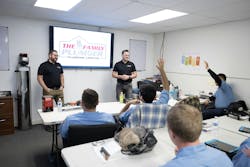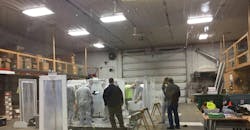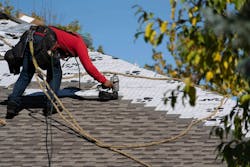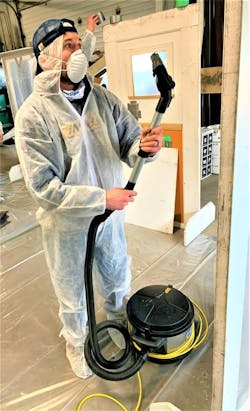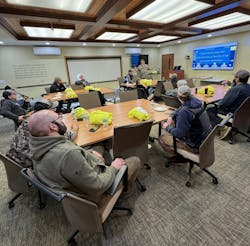Building a culture of safety for any company starts with safety protocols and procedures through proper employee communication, monitoring, reporting and execution. “Listening to employees is key,” says Jason Manning, Safety Manager, Lindus Construction, Baldwin, WI, which fosters a culture of safety by utilizing team member input, site safety inspections, on-the-job training, and an open line of communication without fear of retaliation.
“We promote and welcome continuous coaching and mentoring, voice of the customer—our team members—constant questions on the hazards they face, and lastly, an active role in getting the personal protective equipment (PPE) and tools to keep them safe while they work,” says Manning.
Fostering a culture of open communication and safety dialogue usually starts with a weekly meeting. At Lindus Construction, every Monday, for example, the safety team discusses a different toolbox topic, talks about the previous week's safety site inspections, and discusses current events that may affect employees in their work areas. The team also holds an open-forum general safety discussion to review safety alerts that resulted from injuries or near misses on jobsites. “This set of protocols facilitates open communication among members of the team and allows for communication of up-to-the-minute pertinent safety information and other related topics,” says Manning.
“Most companies believe or expect common sense to prevail when it comes to safety; however, safety on any jobsite big or small needs to be trained on and re-enforced,” says Mike Prencavage Jr., Owner, The Family Plumber, Los Alamitos, Calif., and that’s why his safety team hosts an all-hands-on company safety meeting every week to ensure that all team members are properly trained on hazards in the workplace. “For example, our shop foreman is responsible for providing detailed examples and often real-world situations that can occur to which safety protocols must be adhered. Random jobsite visits from project managers are a must to ensure that all team members are performing work safely as to not endanger themselves or homeowners,” says Prencavage Jr.
Age is Only a Number?
Perhaps fake news, there is a common thought that older employees and/or newbies to the company need safety training the most. “This is always a double-edged sword,” says Manning. “Newer team members might be tempted to rush and perform jobs in which they lack experience, whereas the tenure team members might want to take short cuts with higher risk because they have ‘done it a million times before,’” says Manning, whose encouragement to both age groups is to perform the job safely, do not cut corners, always consider the risks before performing the job. “We want our employees to go home in the same or better condition than when they came to work.”
According to Prencavage Jr., most senior employees understand or have experienced the result of cutting corners with safety standards. “Receive a cut, bruise or worse once in your life and it changes the way you think about approaching certain risky situations,” says Prencavage Jr.
Age plays a factor because more often than not, says Prencavage Jr., “You don’t know what you don’t know. Youthfulness is great but it certainly doesn’t put a bulletproof vest around you. It’s best practice if you share the worst-case safety scenarios with younger employees as much as possible with the hope that if they encounter something similar, they are well prepared to the take the right steps for safety,” says Prencavage Jr.
The AI Advantage
The emergence of Artificial Intelligence (AI) can help businesses in a multitude of ways, particularly when it comes to safety. “AI in different forms can help with developing, implementing or enforcing proper safety protocols within one’s business,” says Prencavage Jr., who also says that some of the biggest examples of these are utilizing AI to create situational safety poster boards for offices or breakrooms, setting meeting reminders or technician meeting periods to review and train on safety standards, or the use of passive integrated driving devices that record and score drivers’ safety behind the wheel.
At Lindus Construction, Manning concurs that AI can help with up-to-date rules, regulations, and guidelines. “In our line of work, we have Federal, State, County, and City codes to follow. [AI] allows us to easily and quickly reference what our expectations are and ensure that we are within these guidelines. AI also helps with the development of Safety Toolbox Topics and quick reference guides for those in the field,” says Manning.
Furthermore, taking full advantage of AI in the workplace, the American Society of Safety Professionals (ASSP) recently launched ASSP Safety Trekr AI, a groundbreaking artificial intelligence-powered search tool designed to fundamentally change how safety professionals access critical workplace safety and health guidance. This innovative solution will accelerate and enhance the work of safety professionals, ultimately reducing the risk of on-the-job injuries, illnesses and fatalities. It also removes communication barriers by engaging safety professionals across multiple languages.
Safety Trekr AI instantly scans and synthesizes the 1,330-page handbook to answer questions and provide precise safety guidance that is based on trusted data and real-world experiences. What once took considerable time through traditional search methods is now available in moments, enabling faster decision-making and more efficient compliance with workplace safety standards
The Insurance Quotient
Insurance is a requirement of all aspects of life, but particularly at work. “We value safety above all else, but we also recognize how it affects the bottom line. Ensuring safety protocol is in place at all times with all employees lowers your overall premiums and keeps you off the high-risk employer lists. We want our employees to be safe every moment on the job so they can return home to their lives outside of work, which is what matters most,” says Manning.
Prencavage Jr. says that insurance is already one of the highest expenditures on a P&L for most construction trade businesses. “The last thing a company would want is to file claims against a policy that increases those rates, not to mention possible revocation. Insurance companies are looking for potential hazards all of the time, and in doing so they can often perform random safety standard compliance checks on companies. It’s best to always have your company ready and in compliance as to not have a policy be canceled,” says Prencavage Jr.
Bottom line, building that culture of safety and employee trust in that culture is paramount. “We set our employees up with the tools they need to put safety first at all times when it comes to themselves and their co-workers,” says Manning.
Prencavage Jr. offers an example at The Family Plumber which includes performing a real fire extinguishing class by preparing a fire pit to be extinguished during the presentation. In addition, safety training videos provided by industry resources should be presented and explained. Lastly, Prencavage Jr. says to always spot check your employees by asking them hypothetical bad safety scenarios on a jobsite and how they would correct them.
“I would encourage companies to make safety learning fun, yet impactful,” says Prencavage Jr.
Top 5 OSHA Safety Violations
In 2024, fall protection was OSHA’s most frequently cited standard, as it has been for the past 14 years. Check out OSHA’s top 5:
1. Fall Protection (6,307 violations)
What to do: Select proper fall protection for each employee and regularly inspect all equipment used for working at heights. Guardrail systems, safety net systems and personal fall arrest systems all offer protection from falling hazards.
2. Hazard Communication (2,888 violations)
What to do: Businesses need to develop, implement and maintain written hazard communication programs describing how they'll maintain warning labels and safety data sheets (SDSs), train employees and meet other relevant OSHA requirements.
3. Ladders (2,507 violations)
What to do: One of OSHA's most frequently violated requirements says that ladders that aren't long enough to extend at least three feet above the upper landing surface must be secured to a rigid support and outfitted with a grab rail or other grasping device.
4. Respiratory Protection (2,407 violations)
What to do: Businesses should provide medical evaluations to determine employees' ability to use respirators at work. They should also make sure employees are fit-tested before they use a respirator for the first time, whenever they switch respirator brands or models, and at least once a year afterward.
5. Lockout/Tagout (2,443 violations)
What to do: The procedures to shut down, isolate, block and secure machines need to be developed and documented, along with specific steps to place, remove and transfer lockout/tagout devices.
Source: Grainger through information provided by OSHA

